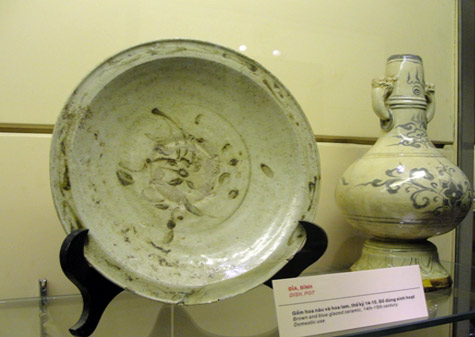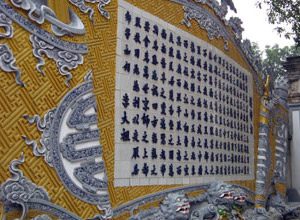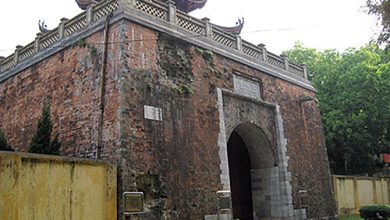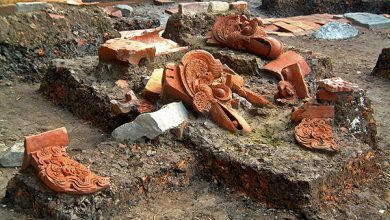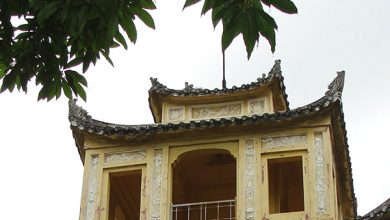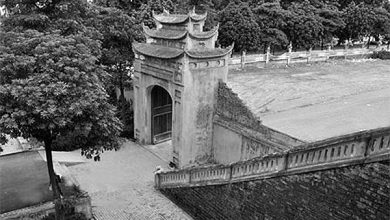Cultural layer of Le Dynasty in 18 Hoang Dieu archaeological area
The top overlaying cultural layer revealed at 18 Hoang Dieu archaeological area is Le Dynasty cultural layer (XVth to XVIIIth centuries). At this cultural layer, archaeologists have discovered the remains of constructions built with wooden-hammer bricks mallet, well systems, bar tiles decorated with five claw dragons for roofing palaces and the royal pottery dedicated to the king and some metal utensils.
Pebble foundation under the Le Dynasty were reinforced with gravel but much more sketchy and at higher depth in comparion with that of the Ly-Tran Dynasties. In other words, the pebble foundation of the Le Dynasty was located higher than that of the Ly-Tran Dynasties. The pedestals were not carved with sophisicated lotus as the Ly – Tran. This can be explained as follows: during the Le Dynasty, Confucianism dominated the No. 1 position, Buddhism was not a religion monopoly. Therefore, the symbol of lotus petals was not widely used anymore. Hence, column pedestals did not have the decoration image of lotus. It was merely a square stone, engraved with a circle on the surface to support the column.
Wells under the Le Dynasty were almost built with rock, including boulder, rubble or slate.Đây là một bước tiến trong kỹ thuật làm giếng khơi, bởi đá có tác dụng thanh lọc nước ngầm rất tốt. This was a technical step in digging deep wells, because rock worked very well at purifying underground water.Bởi vậy, nước giếng khơi được xây dựng bằng đá thường có độ trong, mát và ngọt cao hơn so với giếng xếp bằng gạch đỏ thông thường. Therefore, water from the deep well built of rock was often purer, cooler and sweeter than that from wells built with usual red bricks.
The white and celadon enamelled ceramics dating from Ly Dynasty are really a big surprise to anyone by their sophistication. White enamelled ceramics under Ly Dynasty achieved the smoothness and shine as Song ceramics, which are known to reach the pinnacle of the art of pottery. The quality of white enamelled ceramics of Ly Dynasty and Song Dynasty were similar to the point that one could only distinguish between the two types through the darkness of the enamel color, ceramic bone or techniques designs. Celadon enamelled dishes engraved with daisy or lotus images were among the product group achieving equal level to Song Dynasty ceramics. These high quality ceramics had bold turquoise glaze and fine white ceramic bone. Waste pottery shards and pieces of wire daisy plates found in the archaeological process have helped scientists assert that white and celadon glazed pottery found here is the product of our craftsmen under Ly Dynasty.
Under Le Dynasty, white enamelled royal pottery was decorated with dragons with 5 powerful sharp claws, the word Quan at the centre, and high-level blue flower pottery painted with dragons and phoenix with very fine lines which are assessed to reach the pinnacle of perfection. Thin white ceramics under Le Dynasty were mostly small plates, of which the ceramic bone was as thin as egg shell; the decorations inside could be seen when the ceramics were illuminated through. Embossed five claw dragons were the symbol of the imperial dragon, a clear sign to show royal pottery. The word Quan in the middle of the disk can be understood as the product of the oven or that used for the king and mandarins. Because the pottery was manufactured with very thin ceramic bone, they were very light. Besides royal pottery with dragons with 5 powerful sharp claws dedicated to the king, at Hoang Dieu relics area, archeologists have also found a lot of pottery is decorated with phoenix bird pictures which were the belongings of queens.
In general, the archaeological remains found in the cultural layer under Le Dynasty reflect quite clearly the ideological rule of a Confucian society cult. It is shown through the style of decoration and distinctively disciplined carving.

